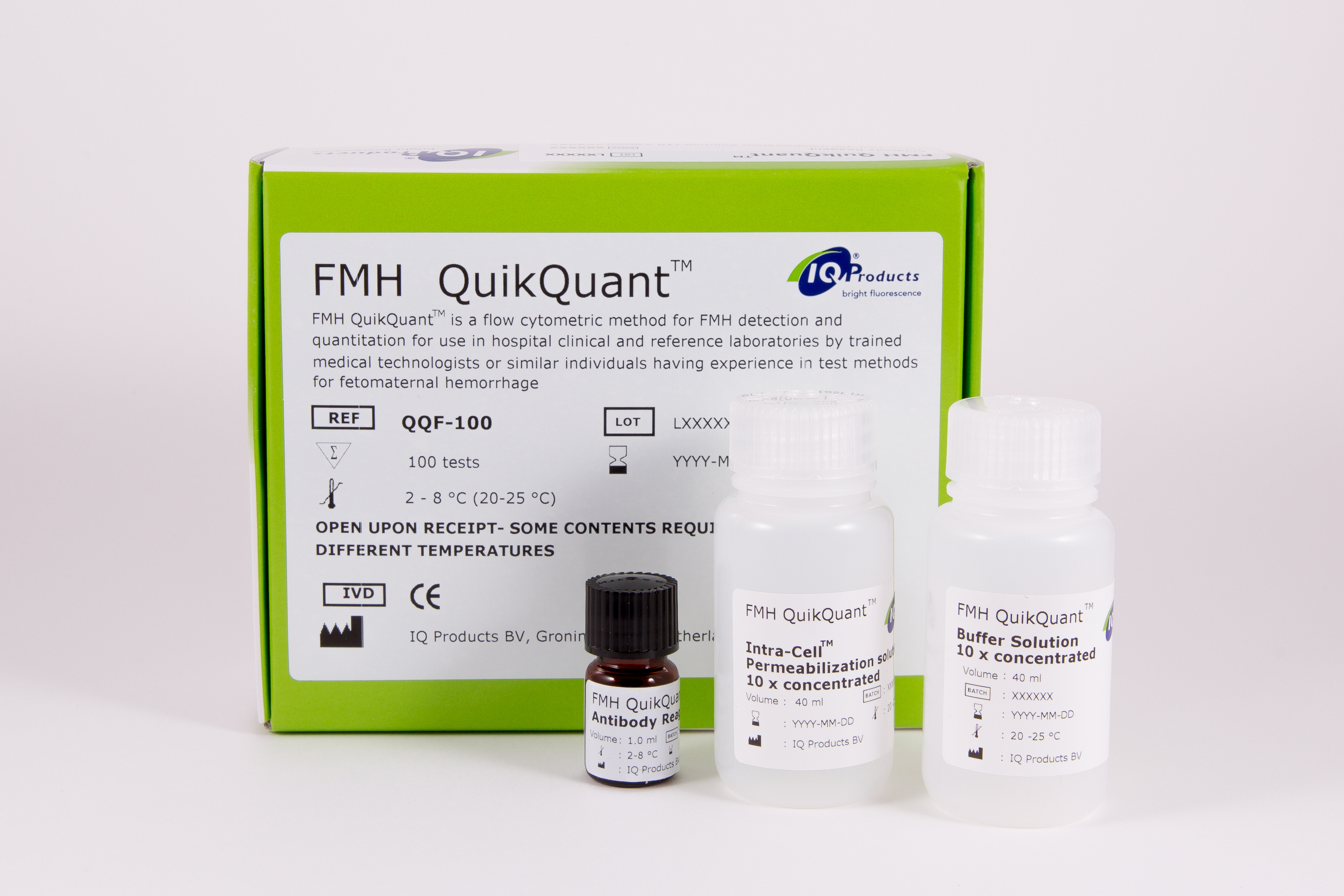FMH QuikQuant™ is a flow cytometric method for Fetomaternal Hemorrhage (FMH) detection and quantitation.
The assay uses a combination of a monoclonal antibody against fetal hemoglobin (HbF) and propidium iodide (PI) as a specific marker of nucleated cells. The method is a rapid streamlined technique requiring about 45 minutes to complete. With less than 15 minutes of technologist time needed, it is more efficient to use than the KB assay, as well as more sensitive and precise.
Key benefits
- Visual separation of maternal RBCs, maternal F cells and fetal RBCs
- Easy and quick to perform assay
- PI provides a definite tool for gating out the WBCs
- FETALtrol™ available as a system control
Features
- Detection of HbF of as low as 0.06% fetal cells in maternal blood
- Results in 45 minutes (15 minutes hands-on-time) with two single centrifuge steps
- Registered as Medical Device for In Vitro Diagnostic Use (IVD/CE)
Applications
- Determination of Fetomaternal Hemorrhage
- Pregnancy with suspected RhD incompatibilities
- Abdominal trauma
Introduction
The most important clinical use of fetal red blood cell (RBC) detection is the diagnosis and quantitation of fetomaternal hemorrhage (FMH). FMH occurs normally throughout pregnancy in minute amounts, with increasing volumes during the later stages of gestation. In case of trauma, complications during delivery or a caesarian section, these amounts can increase and cause serious harm to the fetus.
RhD incompatibility
If there is a significant difference in the RBC antigenicity between the fetus and mother, this can result in allosensitization of the maternal immune system either before or after parturition. Maternal antibodies against fetal RBC antigens may be clinically silent or cause life-threatening autoimmune sequelae for the current or subsequent pregnancies (e.g.: erythroblastosis fetalis or early abortion). Such sensitization can occur with any RBC antigen mismatch, but the highest frequency and profound clinical consequences occur with Rh or D-antigen mismatches.
Prophylaxis with anti-D
Detection and enumeration of fetal RBCs is an essential part of the management of those patients with FMH treated with Rh immune globulin (RhIG) preparations. The use of Rh immune globulin prophylaxis is a universal practice, but dosing amounts and schedules have regional variations. Hence, the sensitivity and specificity of detection assays for FMH is a critical factor in therapeutic efficacy and subsequent clinical outcome.
Flow cytometry versus Kleihauer Betke
The most widely used assay for FMH detection has been the visual microscopic counting Kleihauer-Betke (KB) method, which is based upon the differences in solubility properties in acid conditions of fetal hemoglobin (HbF) from adult hemoglobin. While the KB method is easily performed by most clinical laboratories, it lacks sensitivity and exhibits poor reproducibility or precision (CVs of 50- 100%). Flow cytometric methods have been developed using the antigenic differences or quantitative assessment of HbF to distinguish fetal RBCs from adult RBCs. These methods are more precise and less subjective. Nonetheless, many laboratories have continued to use the KB method due to the limited availability of flow cytometry.
Current literature utilizing and supporting FMH QuikQuant™:
1. Wong et al., Automated quantitation of fetomaternal hemorrhage by flow cytometry for HbF-containing fetal red blood cells using probability state modeling. Int J Lab Hematol. 2013 Oct;35(5):548-54.
2. Pastoret et al., Evaluation of FMH QuikQuant for the detection and quantification of fetomaternal hemorrhage. Cytometry B Clin Cytom. 2013 Jan-Feb;84(1):37-43.
3. Fong et al,.Evaluation of a new rapid anti-HbF FITC assay, Trillium QuikQuant, for detection and quantitation of foetomaternal haemorrhage. Int J Lab Hematol. 2013 Feb;35(1):106-10.
4. De Wit., Reference values of fetal erythrocytes in maternal blood during pregnancy established using flow cytometry. Am J Clin Pathol. 2011 Oct;136(4):631-6.
Question: What is recommended to use as a positive control for HbF if you don’t have cord blood available?
Answer: FETALtrol™ can be used as an external control. This is a quality controlled tri-level stabilized blood control with a known percentage of HbF positive cells in adult blood.
Question: How do you exclude nucleated cells from the analysis?
Answer: Propodium Iodide is used to stain the nuclei of the nucleated cells after permeabilization. During the analysis, these cells can be gated out.

